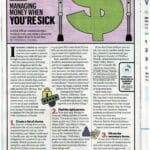
Not only has the COVID-19 pandemic upended life across the globe, it has also affected the financial lives of millions of individuals and families. In the United States, more than 22 million people applied for unemployment (Washington Post) by mid-April. Those who still have a job don’t know for how much longer they will be employed or whether their work hours will be reduced.
We still have bills to pay. We want to keep our families secure and safe. Putting together an emergency spending plan can help ease the stress and uncertainty of our current financial crisis.
Developing a spending plan means examining and prioritizing all expenses and separating wants from needs. The effort is worth it. You will have a well-thought-out map of how you will pay your bills. Here are the steps:
Gather Your Resources
You need to know how much cash you have available. In addition to your bank account balances, do you have other pots of money you can include? This could be funds tucked away for a vacation or a special purchase. (You may need to set those plans aside for now.) Do you have gift cards you can use for necessary purchases, or credit card cash rewards you can redeem? Are you receiving any unemployment or other benefits? Is anyone in your household receiving a paycheck? Can you pick up a temporary work-at-home job? Do you any unclaimed money held by your state? Total the amount available from all sources.
If you have emergency savings, it is worth reviewing your account balance and identifying other sources of funds. There is much uncertainty in the U.S. economy right now, making it important to tap into emergency savings wisely. [Forbes: 4 ways to stretch your emergency fund]
List Your Expenses
Only when you have a picture of your current expenses can you make good decisions. Start by making a list of your bills and the average monthly payment. You can locate many of them on your bank and credit card statements. Review your statements from the past 12 months to catch bills paid a few times a year, such as property taxes and insurance.

Prioritize Your Expenses
Once you have a list, you can determine your essential expenses and prioritize your payments. The National Consumer Law Center (NCLC), a nonprofit focused on consumer advocacy, advises consumers to “prioritize debts whose non-payment immediately harms your family.” These are survival expenses.
The highest priorities are:
- Housing (rent and mortgages)
- Food
Other top priority bills are:
- Auto loans and leases
- Basic utilities (water, gas, electricity, etc.)
- Child support
Lower priority bills are:
- Medical debt
- Credit cards
- Student loans
- Debts you incurred as a cosigner (only when you have not put up any collateral)
- Charge cards with merchants
- Debt owed to friends and relatives
Cut Your Spending
Identify expenses you can eliminate, lower, or pause – at least for the time being. This includes ordering meals out, buying unnecessary items, and paying for subscriptions and memberships you are not using. Can you reduce your television service? Can you cancel or pause your gym membership? If you are not driving your car to work, can you negotiate a lower insurance premium? Are there recurring charges on your credit cards you can stop?
Reach Out
Contact your landlord, lenders, and utility and other service providers. Explain your situation and ask for a new payment arrangement. They may be willing to work with you. Contacting the companies and being up front with them is better than ignoring bills and skipping payments. This could lead to long-term financial damage.
The government and many companies are offering temporary relief.
- IRS: Federal taxes are not due until July 15.
- Many states and large cities have put a moratorium on evictions. (Grow)
- Some banks are letting mortgage customers defer payments. (CNN)
- Some credit card companies are allowing consumers to skip payments. (Business Insider)
- Federal student loan payments, according to Federal Student Aid, have been delayed.
- Most states have ordered a moratorium on utility suspensions. (NCLC)
Before you participate in these programs, understand the repayment terms (Forbes). Some lenders and services are requiring all the skipped payments to be repaid in one lump sum at the end of the forbearance or grace period. Will you be able to do this, or would this lead to more financial hardship? It may be better to make partial payments.
Put It All Together
Once you have eliminated unnecessary spending and contacted each company, go back to your list of priorities and record what your payment will be for each one. If you have insufficient funds to pay all the bills, those lower on the priority list may have to wait.
The COVID-19 pandemic unexpectedly brought financial stress to our lives. Having reduced or no income creates unease around keeping our housing and paying bills. By taking time to create an emergency spending plan, you will be prepared to address your financial obligations and the care of your family in these unprecedented times.
————
By Robyn Young, CDMM and owner of Money Care, LLC in Williston, Vermont. She blogs regularly on her Money Care blog.





















